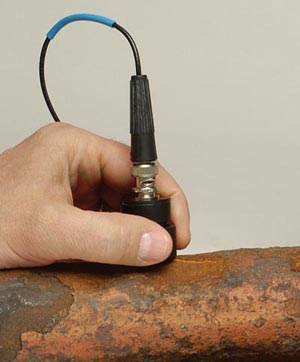A/B - SCAN EMAT
Research, mapping of worn areas and measurement of residual thicknesses. Scanning using special “trolleys” allows for complete inspection of areas of interest; the A-SCAN view shows the thickness values and allows the distinction between the “echoes” of the opposite surface and of discontinuities such as inclusions, “double laminations” and voids; and the B-scan view registers the thickness profile of the region, providing a visualization of the wear morphology and the residual thicknesses of each point.
The use of EMAT (Electromagnetic-Acoustic) type heads allows the total inspection of tubes that operate at high temperatures, such as furnace tubes and boiler superheaters, with a minimum of access, a minimum of surface preparation and even without cleaning, and without the use of couplants. The method is highly versatile, agile and accurate.
Knowing 100% of the superheater tube thicknesses is essential for calculating the stresses acting at each point, and consequent predictions of creep life.
The technique is fundamental and very practical for inspecting boiler furnace tubes for localized thickness losses caused, for example, by corrosion-under-deposits.
The use of EMAT (Electromagnetic-Acoustic) type heads allows the total inspection of tubes that operate at high temperatures, such as furnace tubes and boiler superheaters, with a minimum of access, a minimum of surface preparation and even without cleaning, and without the use of couplants. The method is highly versatile, agile and accurate.
Knowing 100% of the superheater tube thicknesses is essential for calculating the stresses acting at each point, and consequent predictions of creep life.
The technique is fundamental and very practical for inspecting boiler furnace tubes for localized thickness losses caused, for example, by corrosion-under-deposits.

